Joint post by Thinking 3D and The Renaissance Mathematicus.
The Silesian friar and mathematician Witelo is one of those shadowy figures in the history of science, whose influence was great but about whom we know very little.
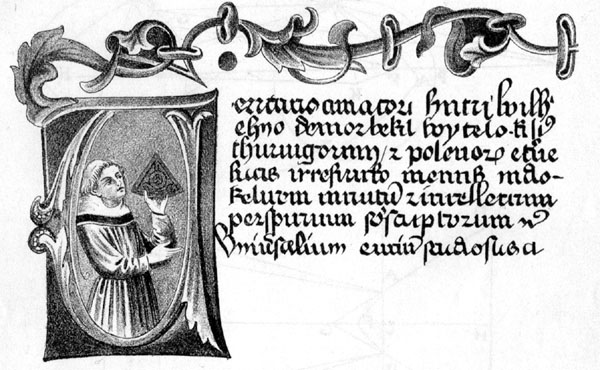
His biography can only be pieced together from scattered comments and references. In his Perspectiva he refers to “our homeland, namely Poland” and mentions Vratizlavia (Wroclaw) and nearby Borek and Liegnitz suggesting that he was born in the area. He also refers to himself as “the son of Thuringians and Poles,” which suggests his father was descended for the Germans of Thuringia who colonized Silesia in the twelfth and thirteenth centuries and his mother was of Polish descent.
A reference to a period spent in Paris and a nighttime brawl that took place in 1253 suggests that he received his undergraduate education there and was probably born in the early 1230s. Another reference indicates that he was a student of canon law in Padua in the 1260s. His Tractatus de primaria causa penitentie et de natura demonum, written in Padua refers to him as “Witelo student of canon law.” In late 1268 or early 1269 he appears in Viterbo, the site of the papal palace. Here he met William of Moerbeke (c. 1220–c. 1286), papal confessor and translator of philosophical and scientific works from Greek into Latin. Witelo dedicated his Perspectiva to William, which suggest a close relationship. This amounts to the sum total of knowledge about Witelo’s biography.
In the printed editions of the Perspectiva he is referred to as Vitellio or Vitello but on the manuscript copies as Witelo, which is a diminutive form of Wito or Wido a common name in thirteenth century Thuringia, so this is probably his correct name. Family names were uncommon in thirteenth-century Poland, and there is no evidence to suggest that Witelo had one.
Witelo’s principle work, his Perspectiva, was not started before 1270, as he uses William of Moerbeke’ translation of Hero of Alexandria’s Catoptrica, which was only completed on 31st December 1269. Witelo is one of three twelfth century authors, along with Roger Bacon (c. 1219–c. 1292) and John Peckham (c. 1230–1292), who popularised and disseminated the optical theories of Abū ʿAlī al-Ḥasan ibn al-Ḥasan ibn al-Haytham, known in Latin as Alhazen or Alhacen. Al-Haytham’s Kitāb al-Manāzir (Book of Optics) was the most important Islamic texts on optics and one of the most important in the whole history of optics. It was translated into Latin by an unknown translator in the late twelfth or early thirteenth century with the title De aspectibus. Bacon was the first European author to include De aspectibus in his various writings on optics and Witelo and Peckham followed his lead. Although it is clear that Witelo used Ptolemy’s Optica, Hero’s Catoptrica and the anonymous De speculis comburentibus in composing his Perspectiva, and that he was aware of Euclid’s Optica, the Pseudo-Euclid Catoptrica and other prominent works on optics, it is very obvious that his major debt is to al-Haytham’s De aspectibus, although he never mentions him by name.
The Perspectiva is a monumental work that runs to nearly five hundred pages in the printed editions. It is divided into ten books:
Book I: Provides the geometric tools necessary to carry out geometrical optics and was actually used as a geometry textbook in the medieval universities. Book II: Covers the nature of radiation, the propagation of light and colour, and the problem of pinhole images. Book III: Covers the physiology, psychology, and geometry of monocular and binocular vision by means of rectilinear radiation. Book IV: Deals with twenty visible intentions other than light and colour, including size, shape, remoteness, corporeity, roughness darkness and beauty. It also deals with errors of perception. Book V: Considers vision by reflected rays: in plane mirrors Book VI: in convex spherical mirrors Book VII: in convex cylindrical and conical mirrors Book VIII: in concave spherical mirrors Book IX: in concave cylindrical, conical, and paraboloidal mirrors Book X: Covers vision by rays refracted at plane or spherical surfaces; it also includes a discussion of the rainbow and other meteorological phenomena.
Witelo’s Perspectiva became a standard textbook for the study of optics and, as already mentioned above, geometry in the European medieval universities; it was used and quoted extensively in university regulations right down to the seventeenth century. The first printed edition of this important optics textbook was edited by Georg Tannstetter (1482–1535) and Peter Apian (1495–1552) and printed and published by Johannes Petreius (c. 1497–1550) in Nürnberg in 1535 under the title Vitellionis Mathematici doctissimi Peri optikēs, id est de natura, ratione & proiectione radiorum visus, luminum, colorum atque formarum, quam vulgo perspectivam vocant.
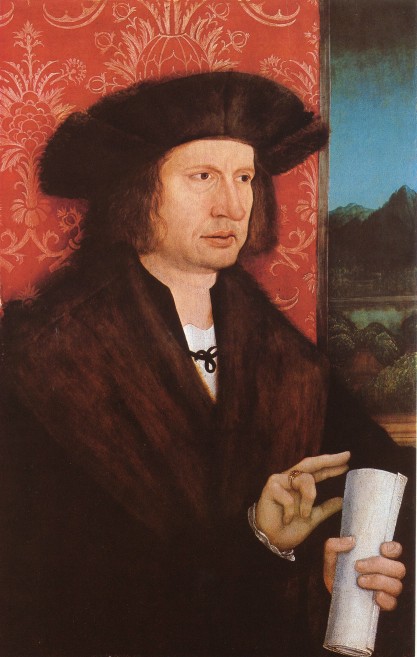
Georg Tannstetter born in Rain am Lech in Bavaria had studied at the University of Ingolstadt under Andreas Stiborius (c. 1464–1515) and when Stiborius followed Conrad Celtis (1459–1508) to Vienna in 1497 to become professor for mathematics on the newly established Collegium poetarum et mathematicorum Tannstetter accompanied him. In 1502 he in turn began to lecture on mathematics in Vienna, the start of an illustrious career.
Peter Apian, possibly his most famous pupil, was born, Peter Bienewitz, in Leisnig. He entered the University of Vienna in 1519 graduating B.A. in 1521. He then moved first to Regensburg and then to Landshut where he began his publishing career with his Cosmographicus liber in 1524.


Following several failed attempts to acquire the position, Apian was appointed printer to the university in Ingolstadt in 1527, as well as lecturer for mathematics, positions he would hold until his death in 1552, when he was succeeded by his son Philipp (1531–1589), who had begun to take over his teaching duties before his death.
Apian’s Ingolstadt printing office continued to produce a steady stream of academic publications, so it comes as somewhat of a surprise that he chose to farm out the printing and publication of his own Instrumentum primi mobilis (1534) and the Tannstetter/Apian edited Witelo Perspectiva (1535) to Johannes Petreius in Nürnberg. Although both books were large and complex it should have been well within Apian’s technical capabilities to print and publish them in his own printing office; in 1540 he printed and published what is almost certainly the most complex science book issued in the sixteenth century, his Astronomicon Caesareum. The problem may have been a financial one, as he consistently had problems getting the university to supply funds to cover the advance cost of printing the books that he published.
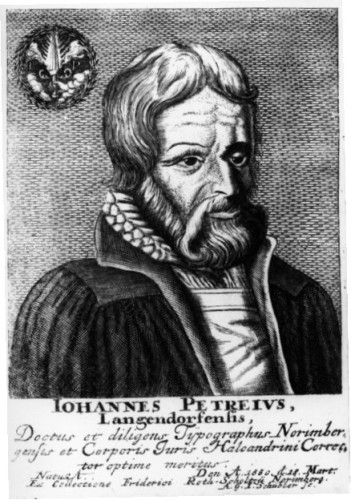
Johannes Petreius, actually Hans Peter, was born in the Lower Franconian village of Langendorf near Hammelburg. He studied at the university in Basel graduating MA in 1517. Here he also learnt the printing trade in the printing office of his uncle Adam Petri (1445–1527). In 1523 he moved to Nürnberg where he set up his own printing business.
By the early 1530s, when Apian approached him, he was one of the leading German printer publishers with a good reputation for publishing mathematical works, although his most famous publication Copernicus’ De revolutionibus orbium coelestium still lay in the future. In fact his publishing catalogue viewed as a whole makes him certainly the most important printer publisher of mathematical books in Germany and probably in the whole of Europe in the first half of the sixteenth century. As was his style he produced handsome volumes of both Apian’s Instrumentum and Witelo’s Perspectiva.
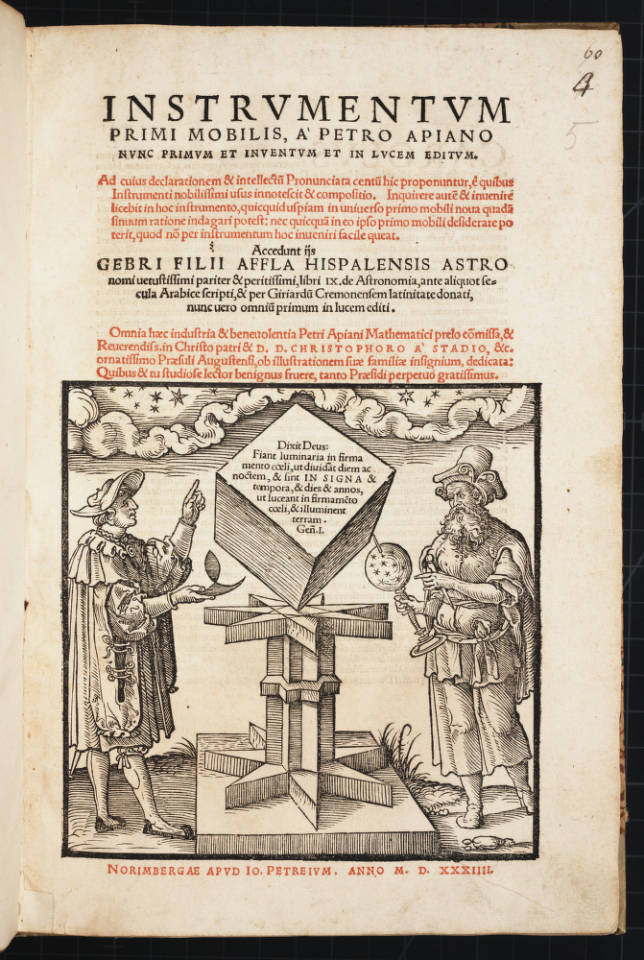
Although he died in 1550 the Petreius printing office would issue an unchanged second edition of the Witelo in 1551, which was obviously in preparation before his death. After his death his business ceased as he had no successor and his catalogue passed to his cousin Heinric Petri (1508–1579) in Basel.
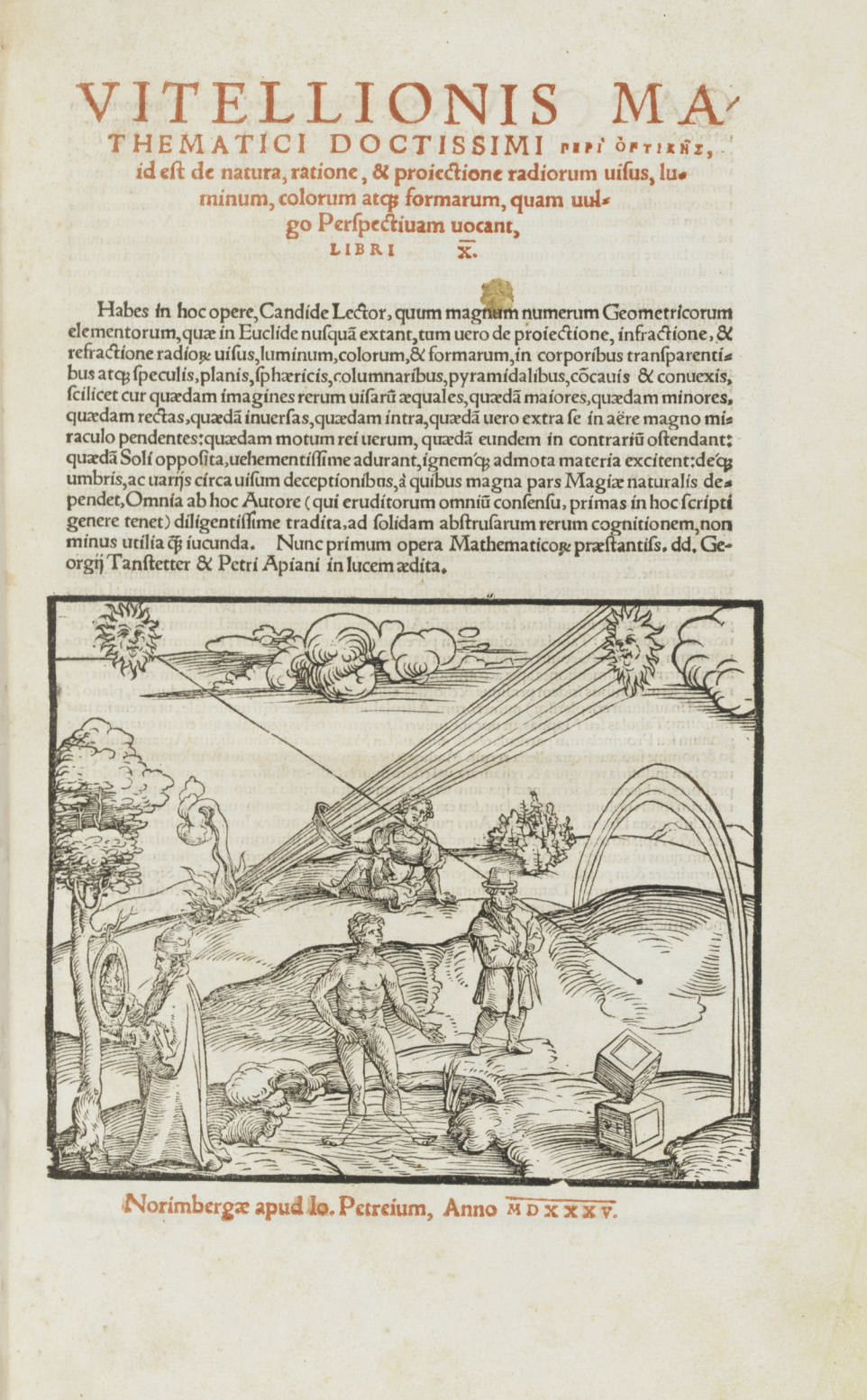
The Witelo volume would come to play a role in the eventual publication of Copernicus’ magnum opus by Petreius. When Georg Joachim Rheticus (1514-1574) set out in 1539 to seek out Copernicus in Frombork he took with him the Witelo tome as one of six specially-bound-as-a-set books, four of which were printed and published by Petreius, as a gift for the Ermländer astronomer. The Petreius books were almost certainly meant to demonstrate to Copernicus what Petreius would do with his book if he allowed him to print it. The mission was a success and in 1542 Rheticus returned to Nürnberg with Copernicus’ precious manuscript for Petreius to print and publish in 1543.
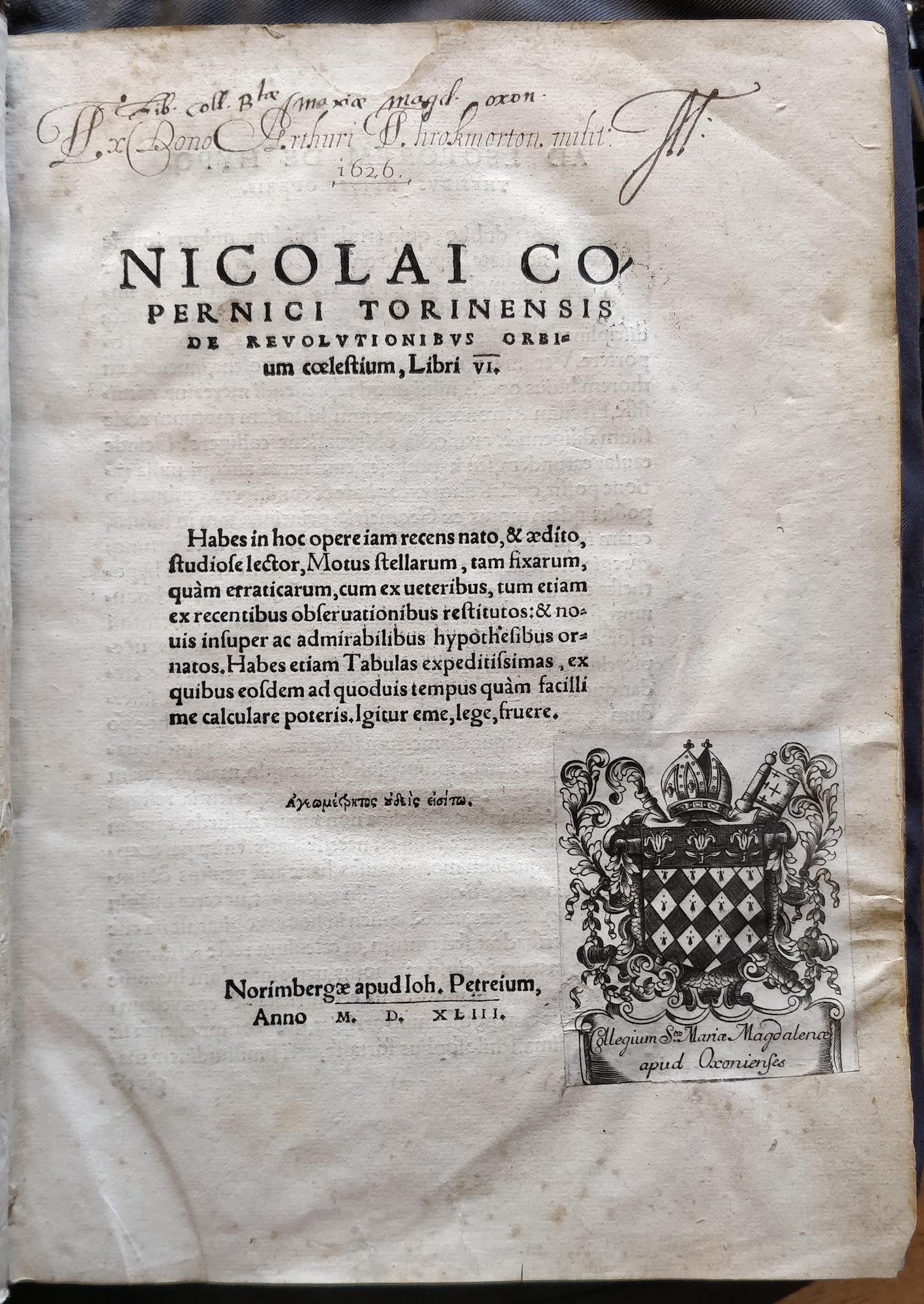
There was a third printed edition of Witelo’s Perspectiva printed and published from a different manuscript by Friedrich Risner (1533–1580) together with al-Haytham’s De aspectibus in a single volume in Basel in 1527 under the title, Opticae thesaurus: Alhazeni Arabis libri septem, nuncprimum editi; Eiusdem liber De Crepusculis et nubium ascensionibus, Item Vitellonis Thuringopoloni libri X.
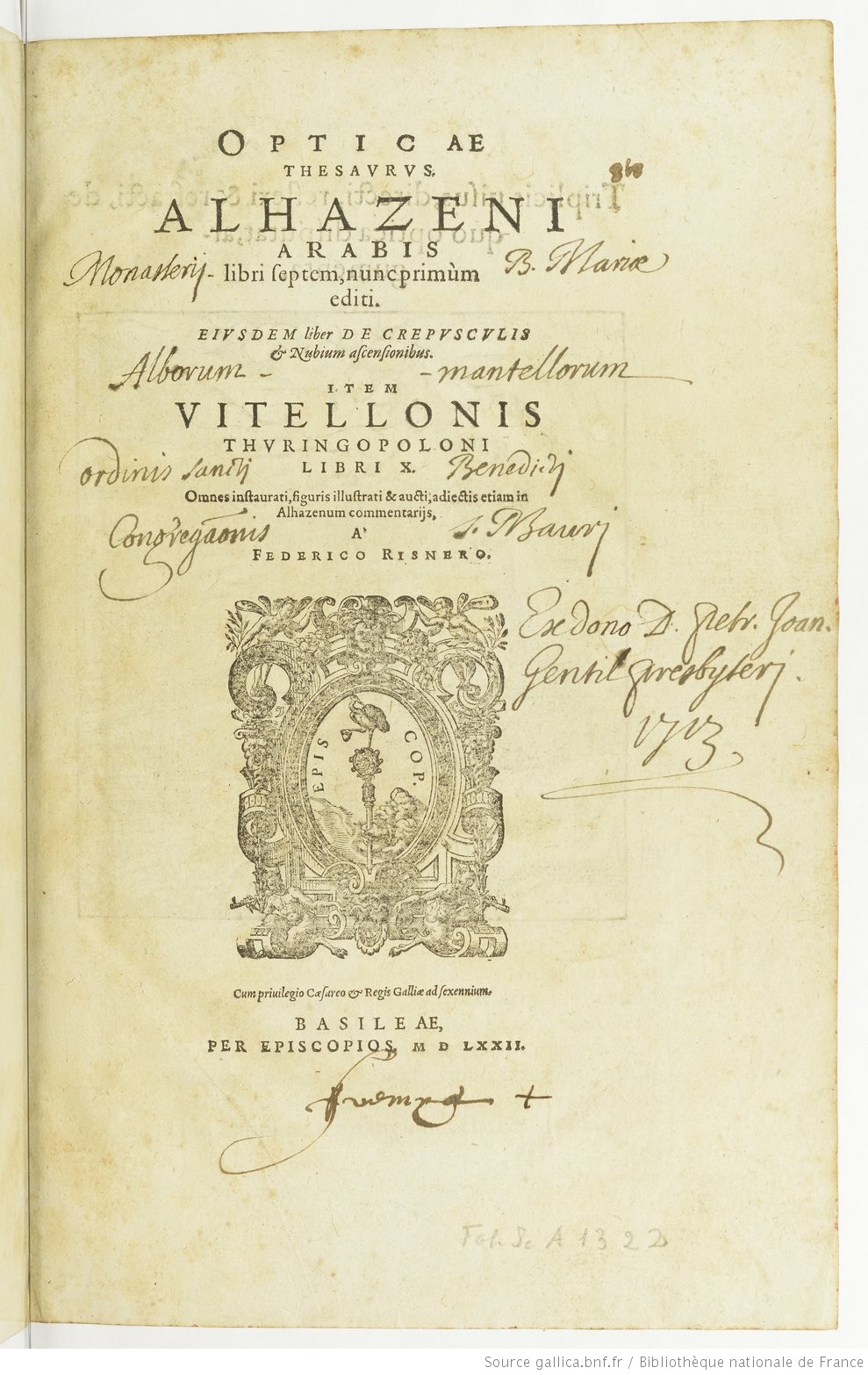
This is the edition that Johannes Kepler (1571–1630) referenced in his Astronomiae pars optica. Ad Vitellionem Paralipomena (The Optical Part of Astronomy: Additions to Witelo) published in Prague in 1604, the most important book on optics since al-Haytham’s.
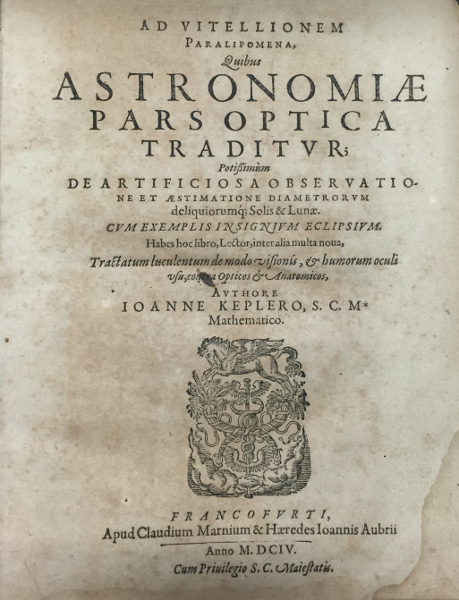
Witelo remains an obscure thirteenth century scholar but his optics magnum opus cast a shadow down more than four hundred years of European history of optics.
Notes
All of the biographical information, and mush else in this article, is taken from David C. Lindberg, Witelo in Complete Dictionary of Scientific Biography, Charles Scribner’s Sons, 2008. Online at Encyclopedia.com.
For more on Witelo’s influence on the history of optics see David C. Lindberg, Theories of Vision from al-Kindi to Kepler, University of Chicago Press, Chicago and London, 1976, ppb. 1981. On Peter Apian a a printer Peter Apian: Astronomie, Kosmographie and Mathematik am Beginn der Neuzeit mit Ausstellungskatalog, ed. Karl Röttel, Polygon-Verlag, Buxheim, Eichstätt, 1995 and Karl Schottenloher, Die Landshunter Buchdrucker des 16. Jahrhundert. Mit einem Anhang: Die Apianusdruckerei in Ingolstadt, Veröffentlichungen der Gutenberg-Gesellschaft XXXI, Mainz, 1930.
